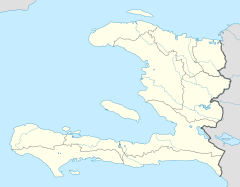Les Cayes facts for kids
Quick facts for kids
Les Cayes
Okay (Haitian Creole)
Aux Cayes
|
|
|---|---|
|
Commune
|
|

Les Cayes Cathedral
|
|
| Country | Haiti |
| Department | Sud |
| Arrondissement | Les Cayes |
| Population
(2015)
|
|
| • Total | 86,780 |
| Time zone | UTC-5 (Eastern) |
| • Summer (DST) | UTC-4 (Eastern) |
Les Cayes (also called Aux Cayes or Okay in Haitian Creole) is an important city and seaport in Haiti. It is located in the Sud department. About 71,236 people live there.
Les Cayes is one of Haiti's main ports. It is known for exporting coffee and sugarcane. The city is also the world's largest supplier of vetiver. Vetiver is a plant used to make perfumes and fragrances. Les Cayes exports about 250 tons of vetiver each year. Other exports include bananas and timber.
Contents
History
Early Settlements
The island of Hispaniola, where Les Cayes is located, was home to indigenous people for thousands of years. The first European town in this area was Salvatierra de la Sabana. Spanish explorer Diego Velázquez de Cuéllar founded it in 1504. Vasco Núñez de Balboa, who later discovered the Pacific Ocean, lived there for some years. This early settlement was abandoned in 1540.
The French later founded the town of Aux Cayes. They named it because it was close to small islands called cayes. The town was hit and destroyed by strong hurricanes in 1781 and 1788. In July 1793, many people living in Les Cayes were killed.
Helping Freedom Fighters
Les Cayes became a safe place for leaders fighting for independence. Simón Bolívar, a famous South American leader, came to Les Cayes in 1815. He met Alexandre Pétion, the President of Haiti. Pétion helped Bolívar by giving him money and military supplies. Bolívar promised to free all enslaved people in the areas he took over.
Mexican leaders Francisco Javier Mina and José Joaquín de Herrera also found safety in Les Cayes during the Mexican War of Independence.
United States Presence
In 1919, American planes flew over Les Cayes. They dropped bombs in what might have been a show of power. Later, in 1929, many Haitians were unhappy with the American presence. People wanted to choose their own leaders.
On December 6, 1929, about 1,500 Haitians held a peaceful protest in Les Cayes. They were protesting local economic problems. During this protest, U.S. Marines fired shots. Between 12 and 22 Haitians died, and 51 were hurt. This event caused anger around the world. The next day, President Herbert Hoover asked the U.S. Congress to look into the situation in Haiti.
Major Natural Disasters
Les Cayes has faced several natural disasters. After the big 2010 Haiti earthquake in January 2010, a Cuban military field hospital was set up in the area to help.
On October 4, 2016, Hurricane Matthew hit Les Cayes. It caused a lot of damage to the city.
On August 14, 2021, a very strong earthquake (magnitude 7.2) struck near Les Cayes. This was the strongest earthquake in Haiti's recent history. It was even stronger than the 2010 earthquake near the capital. The earthquake killed over 2,200 people and injured about 12,700. Most of these people were in Les Cayes and nearby areas.
Tourism
Les Cayes is an important place for tourism in Haiti. It has many beautiful sights:
- Gelée Beach: This is one of Haiti's longest and most visited beaches. It has white sand and is famous for its restaurants. These restaurants serve local dishes like tonm-tonm and grilled seafood. Gelée Beach also hosts an annual music festival in mid-August. Many visitors from Haiti and the USA come to spend the weekend here.
- The Botanical Garden of Les Cayes (Jardin Botanique des Cayes): This garden is located at the northern entrance of the city. It covers an area of eight hectares (about 20 acres).
Other interesting places for tourists nearby include:
- Île à Vache (Cow Island)
- Pic Macaya (a mountain)
- Saut-Mathurine falls and Kounoubois cave in Camp-Perrin
- Pointe-de-Sable beach in Port-Salut
- Marie-Jeanne cave in Port-a-Piment
- Fort des Oliviers, Fort Anglais, and Bonnet Carré in Saint Louis du Sud (in Arrondissement Aquin)
Facilities
Airport
Les Cayes has an airport called Antoine-Simon Airport. In 2013, work began to make it an international airport. The plan includes a new 3,000-meter runway and a new terminal. This project aims to help tourism grow in the Southern Region of Haiti. Haitian officials believe it will create many new jobs. Another airport project is also planned for the nearby island of Île-à-Vache.
Universities
Les Cayes has several places for higher education:
- The American University of the Caribbean, Haiti
- The Public University of The South in Les Cayes (UPSAC)
- The Law and Economics School of Les Cayes (EDSEC)
Hospital
Hôpital Immaculée Conception (Immaculate Conception Hospital), also known as HIC-Cayes, is the public hospital for Les Cayes. It serves the entire South Department. The hospital has an emergency room, a maternity ward, and a dental clinic.
Sport
Les Cayes is home to two professional football (soccer) clubs:
- America des Cayes
- FC Juventus des Cayes
Notable People
Many notable people were born or lived in Les Cayes:
- John James Audubon, a famous French-American naturalist.
- Euphémie Daguilh, a royal mistress to the Haitian emperor Jean-Jacques Dessalines.
- Jean Joseph Maurice Dartigue (1903-1983), who served as a Minister in the Haitian government.
- Auguste Davezac, a United States Ambassador to the Netherlands.
- André Corvington, an Olympic fencer.
- André Rigaud, a Haitian revolutionary leader.
- Assotto Saint, a writer and artist.
- Horace Pauleus Sannon (1870-1938), a Haitian historian and politician.
Villages
- Yersleres
Images for kids
See also
 In Spanish: Los Cayos para niños
In Spanish: Los Cayos para niños



